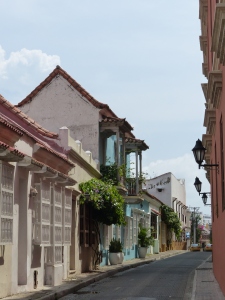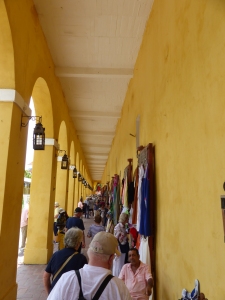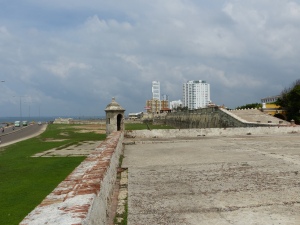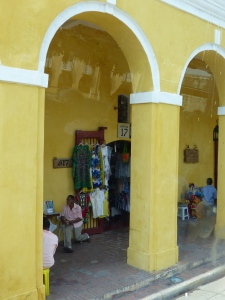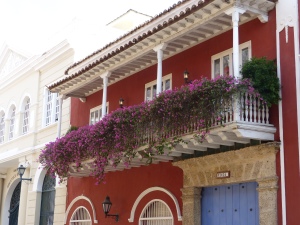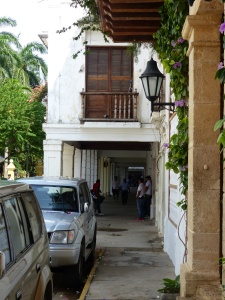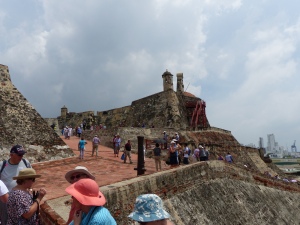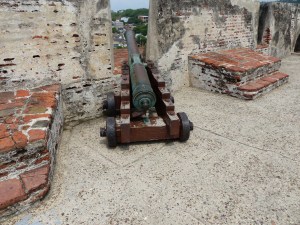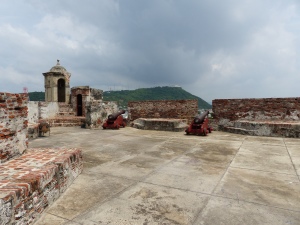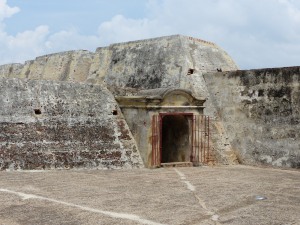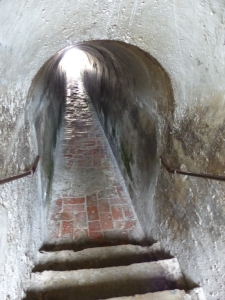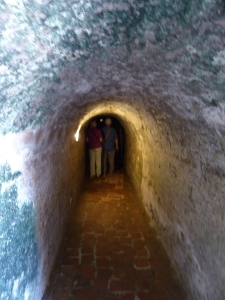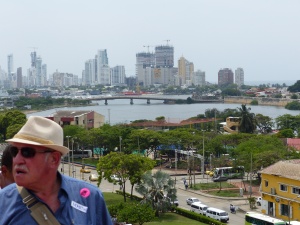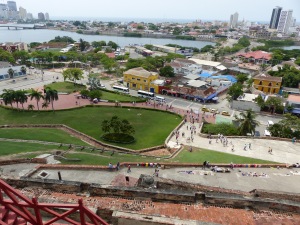We took a winding, scenic route to the old city, and the minute we could see in the walls, it was clear that there was no way the bus was going to fit into the streets. We’d be walking, which was just fine by me.
While the old city is walled and had cannon mounted at one time,
and is a historical artifact in its own right (although not, like the fort, designated a world heritage site by the UN), it’s still in use, and cannonballs are now used for decoration rather than defense.
The walls, where the soldiers barracks used to be are now tourist stalls,
and we walked down past the stores and up onto the walls of the city, where we saw the guard kiosks.
Al and I were totally unprepared for the aggressive sales we found in Cartegana. Street vendors were all over the place, and while they respected your “no”, there were always more of them. And it is a bargaining culture – they offer $50.00 and you counter with $10 and worked your way to a compromise that satisfies both parties. We’re not bargainers, Al and I, and we were really uncomfortable with the fact that not only the street vendors were aggressive and bargainers, so were the propeitors of all the stores – we stopped in some of the more upscale tourist shops in the new city and found the same thing. They stand outside the stores, trying to talk customers in, and once you’re in, salespeople follow you around until you leave the store. When I tried to look at emeralds (to admire, not to buy, but boy, I saw some nice stuff!) I was shadowed by a clerk, who kept trying to show me things she thought I’d want. She wasn’t being rude or hard sell, she was just there, always, no matter where in the shop I went. Very disconcerting for me, since I don’t respond well to that kind of attention. And the prices weren’t fixed even in those stores – the listed price was a starting point.
But in old city, most of the shops were closed for the day and except for the street vendors, we were able to walk and look and listen to our guide describe the city, what it had been and what it was now. We saw the place Marlon Brando had stayed while filming in the old city back in 1968, and admired the feel, look and scents of the place. It’s a living museum. The buildings inside the walls are now hotels, condominiums, city administration buildings, shops, café’s and nightclubs, as well as churches and cathedrals, but the look and feel of the exteriors is preserved and it’s got a lovely, warm (that has nothing to do with temperature) charm.
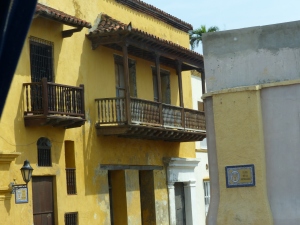 This would be an upper class dwelling, as it’s three storied.
This would be an upper class dwelling, as it’s three storied.
This is middle-class – two stories
And also middle class – two stories.
The area was originally divided into poor, middle-class and upper class buildings, and it was easy to tell which building fit into which class – single story buildings were for the poor, two story were for middle class and three were for the rich. Every residence had a walled courtyard, no matter how single story they were.
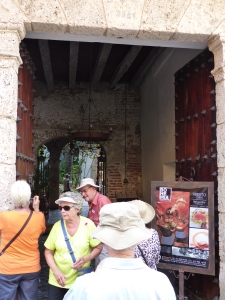 This used to be a private house, three storied, and is now a hotel. It’s an incredibly upscale area with condo units going for around $1M US or better. We’re looking through the entry into the courtyard. Directly across from the main entrance is the entrance to the stables, which formed one of the wings of the house – stable on the ground floor, living area above it and a private, walled garden of your own.
This used to be a private house, three storied, and is now a hotel. It’s an incredibly upscale area with condo units going for around $1M US or better. We’re looking through the entry into the courtyard. Directly across from the main entrance is the entrance to the stables, which formed one of the wings of the house – stable on the ground floor, living area above it and a private, walled garden of your own.
There had been a number of convents, monasteries and churches in the original city, all of which were either hotels or condominiums now. One is now a museum, and the city’s cathedral is also in old town.
We stopped at St. Pedro Claver Church, named for the local saint, who is known as the slave to the slaves, the Apostle of the Blacks and is the patron saint of seafarers. The church houses his relics and has the museum in the monastery attached to the church. The church building has been there since before St. Pedro’s time (he arrived in Cartagena in 1610 and died there in 1654) under a different name. It was renamed for him after his canonization in 1888. The courtyard (or cloister) was lovely – walled on one side with the monastery, and on the other by the church, it was shady, large and relatively cool. There were paths around gardens that housed palm trees and local plants (many of which we grow in tiny form as house plants – I saw sanseveria, coleus, and several other types I can’t name.) There were two street vendors with tame parrots – colourful fellows, who would sit on your arm for a fee. Right up until one of them tried to bite the fellow holding his mate!
We entered the San Pedro church and were able to get a look at St. Pedro’s relics. He was a Jesuit priest who made it his special mission to minister to the slaves of the area, and since Cartegana was such a major port, there were always slave ships bringing people from Africa to work in the mines in South America, or to be sold for transport to the Carribean and Central America. Ten thousand a year.
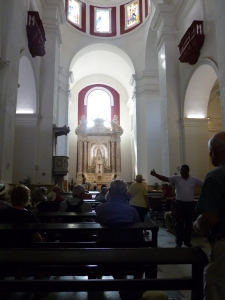 Altar in the far background, the relics are below it in a glass walled coffin.
Altar in the far background, the relics are below it in a glass walled coffin.
He would climb into the ships and begin his work before they were even offloaded, and continued ministering to the slaves in and around the city for over 40 years. It’s estimated that he ended up baptizing over 300,000 people in his lifetime. When he visited slaves on the plantations and at the mines, he refused the hospitality of the owners and overseers and instead stayed in the slave quarters. Needless to say, he annoyed the local authorities (including his bishop), because he advocated for more humane treatment for the slaves, but city authorities bowed to popular demand and gave him an elaborate and public funeral.
The relics are housed beneath the altar in a glass sided coffin, and he’s robed magnificently – probably far more richly than he ever was in his lifetime, considering he died neglected, starved and beaten by the ex-slave sent to care for him in the last years of his life.
There was more to see and more to do – of which we’ll learn tomorrow, and we’ll find out what problems the kitchens on the ship had at dinnertime. In the meantime, enjoy the day!
